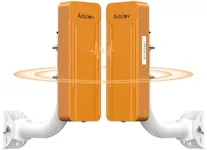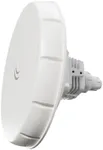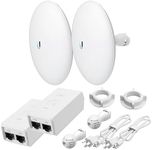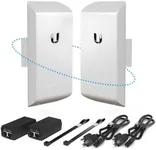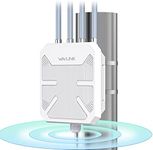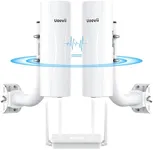Buying Guide for the Best Wireless Bridges
Wireless bridges are devices that connect two or more network segments wirelessly, allowing them to communicate as if they were on the same local network. They are particularly useful for extending network coverage to areas where running cables would be impractical or too expensive. When choosing a wireless bridge, it's important to consider several key specifications to ensure it meets your needs and provides reliable performance.Frequency BandThe frequency band refers to the radio frequencies that the wireless bridge uses to transmit data. Common bands are 2.4 GHz and 5 GHz. The 2.4 GHz band offers longer range but is more prone to interference from other devices, while the 5 GHz band provides faster speeds and less interference but has a shorter range. If you need to cover a larger area with fewer obstacles, 2.4 GHz might be better. For higher speeds and less interference in a smaller area, 5 GHz is preferable.
Data Transfer RateThe data transfer rate indicates the maximum speed at which data can be transmitted between the wireless bridge and connected devices, usually measured in megabits per second (Mbps) or gigabits per second (Gbps). Higher data transfer rates mean faster network performance. For basic internet browsing and email, lower rates (up to 300 Mbps) are sufficient. For streaming, gaming, or transferring large files, look for higher rates (600 Mbps and above). Choose a rate that matches your internet speed and usage needs.
RangeThe range of a wireless bridge is the maximum distance over which it can maintain a reliable connection. This is typically measured in meters or kilometers. A longer range is important for connecting distant buildings or covering large outdoor areas. For indoor use or shorter distances, a shorter range may be sufficient. Consider the physical environment and any obstacles that might affect signal strength when determining the range you need.
Antenna TypeThe antenna type affects the direction and strength of the wireless signal. Omnidirectional antennas broadcast signals in all directions, making them suitable for general coverage. Directional antennas focus the signal in a specific direction, providing a stronger connection over longer distances. If you need to connect two fixed points, a directional antenna is ideal. For broader coverage in multiple directions, an omnidirectional antenna is better.
Security FeaturesSecurity features protect your network from unauthorized access and data breaches. Look for wireless bridges that support encryption standards like WPA2 or WPA3, which provide strong security for your data. Additional features like MAC address filtering and firewalls can further enhance security. Choose a device with robust security features to ensure your network remains safe from potential threats.
CompatibilityCompatibility refers to the ability of the wireless bridge to work with your existing network equipment and standards. Ensure the bridge supports the same Wi-Fi standards (e.g., 802.11ac, 802.11n) as your other devices. Compatibility with your router and other network hardware is crucial for seamless integration. Check the specifications of your current equipment and choose a wireless bridge that matches those standards.
Ease of InstallationEase of installation is important, especially if you are not technically inclined. Some wireless bridges come with user-friendly setup wizards and clear instructions, while others may require more advanced networking knowledge. Look for devices with straightforward installation processes and good customer support. If you prefer a hassle-free setup, choose a wireless bridge that is known for its ease of installation.




